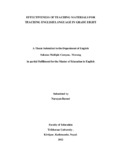Please use this identifier to cite or link to this item:
https://elibrary.tucl.edu.np/handle/123456789/3545| Title: | Effectiveness of Teaching Materials for Teaching English Language in Grade Eight |
| Authors: | Basnet, Narayan |
| Keywords: | Teaching Materials;English language;Teaching English |
| Issue Date: | 2012 |
| Publisher: | Faculty of English Education |
| Level: | Masters |
| Abstract: | The present study entitled "Effectiveness of Teaching Materials for Teaching English Language in Grade Eight" for this, Shree Jyoti secondary school, Topgachhi, Jhapa was selected purposively. Thirty students studying in grade 8 were the primary source, since the primary date for the study were obtained by administering tests among them. Then they were divided into two groups on basis of result of test to make equal level of proficiency of both the groups and were termed as 'control' and 'experimental'. Both the groups were taught the selected items for the equal length of time by the researcher. But the control groups were taught without using teaching materials, except the textbook and blackboard, whereas, the experimental group was taught using teaching materials. At the end of the classroom teaching, a post-test was administered with the same set of items used in the pre-test. The obtained data were compared, analyzed and interpreted to determine the effectiveness of teaching materials. The study found that the teaching materials have very high positive effect on teaching English, since the experimental group performed better in all the areas in post-test except in listening ,with higher progress rate in comparison to that of 'Control' group whereas ,live voice of the teacher was found effective to teach listening. This thesis comprises four chapters. Chapter One deals with the introduction of teaching with the short history of their use in teaching the English language in Nepali .It also includes the review the related literature, objectives of the study and significance of the study. Chapter Two deals with the sources of data, population and sample procedure, process of data collection and limitations of the study. The researcher has used both the primary and secondary sources of data.The third chapter consists of analysis and interpretation of the collected data. To analyzed the data, the average scores were tabulated and the differences between pre-test and post test was calculated in terms of average scores and percentage. The group which had higher progress rate was regarded better group. Chapter Four deals with the findings recommendation s of the study the findings have been outlined on the basis of the analysis and interpretation of the data, and appropriate recommendation and pedagogical implications have been made. |
| URI: | http://elibrary.tucl.edu.np/handle/123456789/3545 |
| Appears in Collections: | English Language Education |
Files in This Item:
| File | Description | Size | Format | |
|---|---|---|---|---|
| cover.pdf | 29.61 kB | Adobe PDF |  View/Open | |
| chapter.pdf | 210.22 kB | Adobe PDF |  View/Open |
Items in DSpace are protected by copyright, with all rights reserved, unless otherwise indicated.
